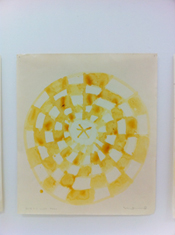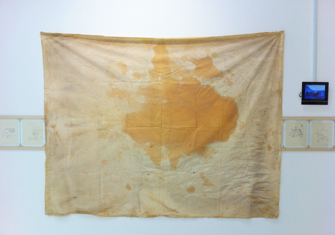 |
Focus features two in-depth reviews each month of fine art, architecture and design exhibitions and events at art museums, galleries and alternative spaces around Japan. The contributors are non-Japanese art critics living in Japan. |
|
|
 |
 |
 |
Katsuhiko Hibino: Why Do People Draw Pictures?
Roger McDonald |
 |
 |
|
 |
| Drawing, Peru-Bolivia, 2006 |
|
Stained cloth, Arctic Circle, Canada, 1994 |
The title of Katsuhiko Hibino's exhibition at 3331 Arts Chiyoda -- "Why do people draw pictures?"-- is a pertinent and timely one. Although painting has "died" countless times over the last one hundred or so years, it remains a medium of supreme simplicity as well as difficulty. Of all the various kinds of art that exist, painting (and its close kin drawing) seem to bear the heaviest historical burden, being directly linked to some of the very first known image-making gestures by our ancestors in caves over 35,000 years ago.
Hibino graduated from the prestigious Tokyo National University of Fine Arts and Music (Geidai) during the 1980s when painting was being "resurrected" by artists like Jean-Michel Basquiat and German new-expressionists like A.R. Penck, and one certainly recognizes their influences in his work. His early cardboard collage drawings from this period, which occupy one gallery in this exhibition, launched Hibino's career. They are fun to look at, depicting commercial-like images of cruise ships, rock bands, soccer stadiums and sewing machines together with English phrases like "Sewing machine now, your sewing machine will be greater and the quality equel to or better than any more" (spelling mistakes included).
Hibino is an avid traveler who has incorporated his wanderings very directly into his art-making. The exhibition is arranged like a travelogue, into geographical sections of the places where he has visited and made drawings. Each section is accompanied by a Google map and a small monitor which loops his photographs of the trip. There are no paintings on canvas in this presentation, only numerous drawings. Mobility and lightness are clearly valued in his nomadic mode. An interesting aspect is seeing how his drawings seem to take on the character of the places he visited. This is obviously one of the key reasons artists have sought out the exotic and the different in cultures far from their own, as we see clearly in the case of Paul Gauguin or Henri Matisse. Hibino's Peru-Bolivia trip led to Aztec/Mayan-like mandalic drawings, Egypt was reflected in very stylized, monumental stick figures, and France was largely mirrored in the small interior details of his hotel room, drawn with a delicate poetic sensibility.
In document videos of his working processes, we see Hibino in Laos working outdoors. He stops every few seconds to look up and take in the atmosphere, even gathering sand from his feet to mix with his paints. This antennae-like sensibility of filtering his immediate environment into drawings seems to lie at the base of Hibino's practice. What I found myself looking for were moments when his output betrayed my own images of a place, rather than confirm stereotypes and forms. The artist-journeyman occupies many roles, among them the tourist who extracts what his audience wishes to see. This complex and engaging process, which has been studied extensively by historians, is what we call exoticism or primitivism.
The one work that immediately stood out for me consisted of two stained cloths made in the Arctic Circle, Canada, in 1994. Reading Hibino's explanation, it became evident that because of the intense frozen environment, his usual plein-air mode of working was impossible. Hibino came across a group of local people skinning a sea lion caught in a hunt, and immediately placed two white sheets under their carcasses as a kind of drawing of this process. Paradoxically, I found the most disturbing and affecting work to be this one: bloodied pieces of cloth which were not drawn by the artist, but which beautifully (and literally) suspend Hibino's sense of estrangement in a foreign place. Faced with something utterly different and unknown, Hibino's simple act of laying cloth on the ground and allowing others to "draw" somehow offered one answer for me to the question posed in the exhibition's title.
 |
Installation view, works from the 1980s
All photographs by Roger McDonald
|
|
|
|
|
 |
Katsuhiko Hibino Solo Exhibition: "Why do people draw pictures?" |
 |
3331 Arts Chiyoda
|
 |
30 October - 13 December 2010 |
|
|
|
 |
 |
Roger McDonald
Roger McDonald was born and brought up in Tokyo, educated in the UK, and returned to live in Japan in 2000 after completing his PhD. He has worked on the Yokohama Triennale 2001 as assistant curator, the Singapore Biennale 2006 as curator, and organised a number of exhibitions and projects independently. He is deputy director of the non-profit curatorial collective Arts Initiative Tokyo, and teaches at Musashino and Joshibi Art Universities. |
|
 |
|